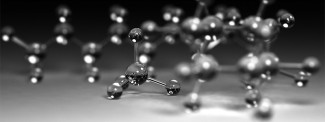Rita Raisman-Vozari, and Patrick Michel, researchers from Etienne Hirsch's team at the Institut du Cerveau - ICM (CNRS, Inserm, UPMC), as well as other researchers from the Biomolecular, Conception, Isolation and Synthesis Lab (CNRS/ParisSud University), led by professor Bruno Figadère, propose the use of a small molecule, 3-phenyl-6-aminoquinoxaline (PAQ), to slow the progression of Parkinson's disease. Capable of crossing the blood-brain barrier, this molecule could protect neurons from disappearing in this disease. This work, funded in part by the CARNOT programme for Future Investments, has just been published in the Journal of Medicinal Chemistry. This discovery could eventually pave the way for a curative treatment of Parkinson's disease.
Small molecule research, which can protect dopaminergic neurons (or dopamine producers) from the numerous events involved in cell death remains an intensive research focus. However, few compounds have shown an effect, both on in vitro neuronal cultures, and in animal models of Parkinson's disease in vivo.
Researchers from the Institut du Cerveau - ICM and the Lab "Biomolecules : conception, isolation and synthesis" have used natural substances and have changed their structure. These natural substances, present in very small quantity in tropical plants of the Annonaceae family, had not however a good pharmacological profile, and were particularly inefficient to go through the blood-brain barrier.
After having synthesized a new compound library and observed their biological activity, they succeeded in characterising a new fully synthetic molecule, the 3-phenyl-6-aminoquinoxaline (PAQ), which perfectly targets neuronal cells. By activating specific receptors, the PAQ manages to restore intracellular calcium balance, one of the mechanisms invoked to explain the neuro-protective effect.
Researchers have highlighted this effect during in vitro studies, in rat dopaminergic neuron primary cultures. Then, in an animal model of Parkinson's disease, they have shown that dopamine concentrations were partially restored to provide nerve impulse.
This work will possibly open the way, ultimately, for a curative treatment for Parkinson's disease.
Sources
New 6-Aminoquinoxaline Derivatives with Neuroprotective Effect on Dopaminergic Neurons in Cellular and Animal Parkinson Disease Models.
http://www.ncbi.nlm.nih.gov/pubmed/27341519
Gael Le Douaron, Laurent Ferrié, Julia E. Sepulveda-Diaz, Majid Amar, Abha Harfouche, Blandine Séon-Méniel, Rita Raisman-Vozari, Patrick P. Michel & Bruno Figadère. J. Med. Chem. 24 juin 2016.







